Soil organisms: Difference between revisions
| Line 3: | Line 3: | ||
Microfauna are organisms that are microscopic in size, and a high-power microscope is needed to observe and identify them. Protists are predominantly unicellular organisms that are the most abundant of the microfauna in soils. There are four main types of soil proists: flagellates, naked amoeba, ciliates and testacea (Figure 1). | Microfauna are organisms that are microscopic in size, and a high-power microscope is needed to observe and identify them. Protists are predominantly unicellular organisms that are the most abundant of the microfauna in soils. There are four main types of soil proists: flagellates, naked amoeba, ciliates and testacea (Figure 1). | ||
===Flagellates=== | ===Flagellates=== | ||
Flagellates can be identified by their flagella (a whip-like swimming appendage) and prey mostly on bacteria. Because of their diet, flagellates play a large role in nutrient turnover [1]. | [[Flagellates]] can be identified by their flagella (a whip-like swimming appendage) and prey mostly on bacteria. Because of their diet, flagellates play a large role in nutrient turnover [1]. | ||
[[File:Naked_amoeba.jpg|200px|thumb|right|Figure 2 [2] - a naked amoeba engulfing its prey (phagocytosis)]] | [[File:Naked_amoeba.jpg|200px|thumb|right|Figure 2 [2] - a naked amoeba engulfing its prey (phagocytosis)]] | ||
===Naked Amoebae=== | ===Naked Amoebae=== | ||
Revision as of 11:53, 15 April 2019
Microfauna
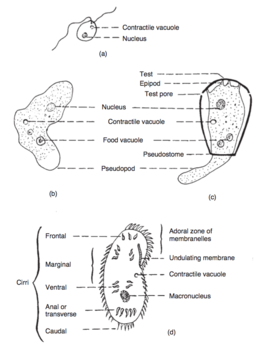
Microfauna are organisms that are microscopic in size, and a high-power microscope is needed to observe and identify them. Protists are predominantly unicellular organisms that are the most abundant of the microfauna in soils. There are four main types of soil proists: flagellates, naked amoeba, ciliates and testacea (Figure 1).
Flagellates
Flagellates can be identified by their flagella (a whip-like swimming appendage) and prey mostly on bacteria. Because of their diet, flagellates play a large role in nutrient turnover [1].
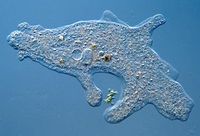
Naked Amoebae
Naked amoebae are phagotrophic, meaning they engulf their prey (Figure 2) including bacteria, fungi, algae, and other organic particulates [1].
Testacea
Testacea, or testate amoebae, are similar to naked amoeba but less abundant and have a shell called a “test” giving it its name. Although most protists are considered cosmopolitan, testate amoebae vary widely by geographical region [3].
Ciliates
Ciliates are organisms that are covered with cilia, a mechanism for transportation. They are found in exclusively moist environments, but this can range from Antarctic ice to hot springs to wetlands [4].
Mesofauna and Macrofauna
Lophotrochozoa
Lophotrochozoans are protostomes that have a lophophore, or a "mouth" surrounded by cilia for feeding. Lophotrochozoans include flatworms, rotifers, annelids, and mollusks.

Rotifera
Rotifera are microscopic (or nearly microscopic) organisms that exist in predominantly wet environments. In soils, they inhabit thin films of water surrounding soil particles and aggregates. They can also be found in puddles and on mosses surrounding decomposing trees [5]. Rotifers feed on bacteria, algae, and other protists by using the cilia near their mouths to create a water current in which prey is caught (Figure 3), making them important bottom-level consumers.
Annelida
Annelids are a phyla of segmented worms divided traditionally into Clitellata (including earthworms and leeches) and Polychaeta (mostly marine worms)[12]. Polychaetes, or bristle worms, have multiple "hairs" (chetae) made from chitin on their segments. Clitellata are hermaphroditic segmented worms that have a reproductive organ which wraps around their bodies called the clitellum. This organ holds and nourishes fertilized eggs until they hatch.
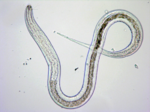
Ecdysozoa
Ecysozoans are organisms that have a chitin exoskeleton, including roundworms, tardigrades and arthropods.
Nematoda
Nematodes, also known as roundworms, are perhaps the most abundant of the mesofauna in soils. The invertibrates have an overall tube-like cylindrical shape which tapers at both ends (Figure 4) [1]. Nematodes can consume prey up to ten times the size of their mouths. They predominantly prey on root hairs, roots, and fungal hyphae [7]. Some entomopathogenic nematodes (those which act as insect parasites) can infect and kill a root-feeding host while producing more than 400,000 offspring (in the case of the large ghost mouth caterpillar) (Figure 4) [1,8].
Tardigrada
Tardigrades are small (500um) organisms that can exist in nearly any environment.
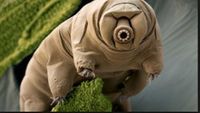
Colloquially called "water bears" for their resemblance to the land-dwelling mammal, these organisms possess the ability to enter a cryptobiotic (near lifeless) state if conditions are unfavorable [10]. Tardigrades serve as a warning sign for environmental stress [1]. These organisms feed on bits of algae and particulate organic matter.
Arthropoda
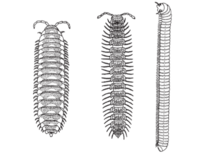
Arthropods, like all ecysozoans, are organisms with a hard exoskeleton and encompass isopods, myriapods, collembola, and mites. Isopods are wide, flat organisms with segmented bodies that feeds on roots, leaves, and detritus. They have jointed appendages and a mandible built to cut leaves for consumption. Due to their susceptibility to desiccation, many have adapted by developing the capability to purify their own urine to reabsorb it [1]. They may also roll into a ball if threatened, which allows them to capitalize on their hard exterior, giving them their more common name, "rolly pollies" or "pill bugs." (Figure 6)

Myriapoda include all mesofauna with long bodies and many legs like millipedes (Diplopoda) and centipedes (Chilopoda)[11]. While millipedes (Figure 7) are detritivores, centipedes are carnivorous with pincer-like fangs that feed mostly on other small organisms like collembolans.
References
[1] Coleman, David C., et al. Fundamentals of Soil Ecology. Elsevier Academic Press, 2004.
[2] Burns, Keanna. “Otherworldly Amoebas.” Future Science Leaders, 31 July 2014, www.futurescienceleaders.com/mariecurious/2014/02/03/otherworldly-amoebas/.
[3] Smith, Humphrey Graham, et al. “Diversity and Biogeography of Testate Amoebae.” Protist Diversity and Geographical Distribution Topics in Biodiversity and Conservation, 2007, pp. 95–109., doi:10.1007/978-90-481-2801-3_8.
[4] Lynn, Denis H. “Ciliophora.” Encyclopedia of Life Sciences, 16 Apr. 2012, doi:10.1002/9780470015902.a0001966.pub3.
[5] Wallace, Robert Lee, and Hillary April Smith. “Rotifera.” Encyclopedia of Life Sciences, vol. 1, 15 May 2013, doi:10.1038/npg.els.0001588.
[6] Howey, Richard L. “The Wonderfully Weird World of Rotifers.” Micscape Microscopy and Microscope Magazine, 1999, www.microscopy-uk.org.uk/mag/indexmag.html?http%3A%2F%2Fwww.microscopy-uk.org.uk%2Fmag%2Fartnov99%2Frotih.html.
[7] Poinar, George. “Nematoda (Roundworms).” Encyclopedia of Life Sciences, 15 May 2012, doi:10.1002/9780470015902.a0001593.pub3.
[8] Strong, D. R., et al. “Entomopathogenic Nematodes: Natural Enemies of Root-Feeding Caterpillars on Bush Lupine.” Oecologia, vol. 108, no. 1, 1996, pp. 167–173., doi:10.1007/bf00333228.
[9] “Marine Nematodes Get New Digs!” National Museum of Natural History Unearthed, 21 Sept. 2015, nmnh.typepad.com/no_bones/2015/09/marine-nematodes-get-new-digs.html.
[10] Miller, W. R. (2011). Tardigrades. American Scientist, 99(5), 384–391. https://doi.org/10.1511/2011.92.384
[11] Wright, Jonathan C. “Myriapoda (Including Centipedes and Millipedes).” Encyclopedia of Life Sciences, Oct. 2012, www.els.net/WileyCDA/ElsArticle/refId-a0001607.html.
[12] Struck, Torsten H, et al. “Annelid Phylogeny and the Status of Sipuncula and Echiura.” BMC Evolutionary Biology, vol. 7, no. 1, 2007, p. 57., doi:10.1186/1471-2148-7-57.